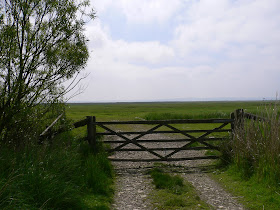
ELMLEY CHURCH AND SCHOOLHOUSE
After overnight drizzle it was a very murky early morning on the Swale NNR at Harty today with bushes dripping water and misty conditions making visibility limited, it was humid as well which added to the gloominess.
As I drove through the thicket and stopped to unlock the entry gate, it appears that a few thrushes had arrived overnight and I counted 6 Song Thrushes, 2 Blackbirds and a couple of Robins. Song Thrushes are a very uncommon bird on the reserve and it was a treat to see them.
Walking along the reserve side of the seawall fleet I came apon a Greylag Goose trailing a damaged wing and unable to fly. Yet another casualty of the wildfowlers' actions on the other side of the seawall and it was amazing to realise that's its only been four weeks since the season began, it seems like months. Anyway, that's another bird that will have to be dispatched as soon as I can get one of his assailants to bring a gundog along and catch it up.
The recent rain has done nothing for ditch levels, they remain basically empty, but it has made the ground softer and where the cattle have been, muddier. It has also brought about an explosion of Crane Fly numbers and walking across the marsh clouds of them now rise up everywhere, I assume that something eats them. It didn't appear to be a huge flock of swallows that was passing through though, they concentrated for a while on feeding along the seawall fleet and its reed beds.
I guess that in the next few days mushrooms will also begin to pepper the fields in large groups, succulent and pink, begging to be taken home and fried up for breakfast.
The one remaining puddle along the "S" bend ditch had a few Teal in it and very briefly, 4 Tufted Duck that dropped in and then moved on to find somewhere that covered more than their feet in water. 2 Snipe also got up from the puddle's edge and that was about it for the "S" bend ditch - in a couple of months time I will be recording ducks in their several hundreds along there, mark my words.
I decided to leave the reserve and went through the boundary gate and into the two RSPB fields currently being reverted to grazing marsh from arable. They are now starting to green up as the grass seed and some rape begins to germinate all over them. A flock of 20 Linnets were feeding in one of the fields, a Green Sandpiper came out of one of the ditches, which also had some Reed Buntings and Meadow Pipits along its banks, and this new small addition to conservation is starting to take shape.
By the time that I had made my way back on to The Swale NNR the sun had begun to burn through the gloom and a Peregrine circled above the barn where I'd parked my car, the day was getting better and lawns at home needed cutting.


